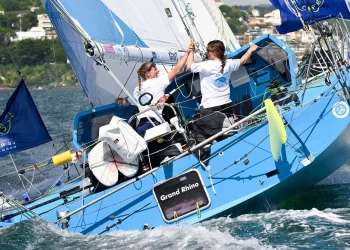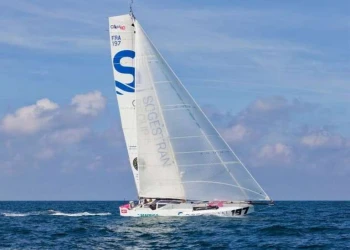
TJV: Imoca Speed tests in the trade winds, options ahead
TJV: Imoca Speed tests in the trade winds, options ahead
Since having had a torrid time for some 1500 miles, at the start of the exclusion zone off the NE corner of Brasil when the Doldrums extended north with them requiring them to gybe more than 20 times over a 36 hour period, the duo have finally had a straight run in the trade winds and are about 200 miles ahead of Sodebo (Thomas Coville and Thomas Rouxel).
For the leaders in the main group in the IMOCA and Class40 races the duos are very much enjoying a trade winds speed test, drag racing in modest seas and 17-22kts trade winds. For the IMOCAs especially this is seen as providing the most invaluable insights and learning in terms of Vendée Globe preparation, much more so than bashing upwind on the northerly route.
New leaders of the Class40 fleet as the peloton heads west in a modest trade wind are Groupe SNEF (Xavier Macaire and Pierre Leboucher).
"We still have some wind, but it's up and down. During the night there was a moment with no wind, but now we're off again. It is also very variable in direction, and isn't always easy to follow. Sometimes we find ourselves without the right sail. On paper, it may look simple, but in reality, it isn't always so," explained Xavier Macaire from Groupe SNEF. Their weather scenario about to be disturbed, the trade winds will lose their intensity, as a low-pressure system moves in across the Atlantic, generating calms to its south.
Macaire, formerly a top Figaro racer, said "It's nice to be back in the leading group with Ambrogio (Alla Grande Pirelli) and Alberto (IBSA). We're fighting it out with them. Sometimes we win, sometimes we lose. It's a bit sad to see our routes diverge, but we're sticking with our strategy. It may pay off or it may not. It offers a possibility of winning, so we grabbed that opportunity right now we don't know whether Amarris who is above us is taking the same route. We should find out in a couple of hours."
There is plenty of suspense in the race this morning. The five frontrunners are within thirty miles of each other in terms of distance to the finish, which is practically nothing given the 160-mile lateral separation between Crédit Mutuel, sailing fast in the North, and the Italian sailors.
In ninth today on T'quila British co-skipper Brian Thompson is happy with the way their race is shaping up, reporting this morning "It is so different now to the start of the race. It was so intense and rough then and now it is amazing trade winds sailing and you are just trying to eke out tiny, marginal gains against our group of four boats around us. You have to know exactly how to make them, sail trim, how much to drive, the pilot set up, where to put the weight, ballast in and we are playing with these little, tiny details. It is quite different now. Now we are looking big picture. We are looking at the models in great detail looking at what is about to happen, so each day it changes. I don't think we have a reliable idea of what will happen. That drives whether we are looking to stay in the trade winds or perhaps go a little bit north an play with the winds behind the front there. Then the question is about how you get down from there. It is still all up in the air, we are keeping on trucking. And Alister (co-skipper) is very happy."
Motorway miles
In the IMOCAs in the South, there is a similar story. Over the past 24 hours, conditions in the trade winds have meant that these boats have moved up the rankings in comparison to those favouring a northern option. Swiss skipper Justine Mettraux on Teamwork.net with Julien Villion is still leading the fleet, but this option is demanding and tiring. "It was a busy night for us. Late yesterday, we crossed a front. Behind it, we had some downwind sailing, but now we're upwind again." Said Mettraux this morning,
In the South the boats are drag racing and the skippers are motivated and they are also able to get the most out of their foilers in these conditions. Jérémie Beyou explains, "In terms of strategy, because we were in front, we tried to get the others to follow us to race with them. We're giving it our all to win in the end."
The only hiccup for the former leader was damage to Charal's gennaker in the ridge of high pressure. "It got torn by a foil that was up. So we had to make do without it down through the Canaries. We sailed like that for around twenty hours so were a bit handicapped and For People and Paprec Arkéa got away from us," explained Beyou this morning.
He also admitted, "Yesterday, we went on a tack a bit to the North, but it didn't really work out." For now, concentration is vital for the Béyou Franck Cammas dream team which has always been among the pacemakers. "We have lighter winds than over the past few days. It's not easy finding enough pressure for the boat to fly and at the right angle, so it's a bit of a compromise," added the co-skipper on Charal.
From the German flagged 11th placed Malizia Seaexplorer Boris Herrmann sailing with Will Harris is enjoying, and learning from the speed test racing in a stable 18-22kts of breeze. Their boat is much lighter since being in The Ocean Race mode and the duo are learning all the time.
"I feel Sam Davies (Initiatives Coeur)has a slight edge on us, sometimes maybe half a knot quicker. If I look at the four hour averages on he tracker – that is the most accurate benchmark – we stick in the same ballpark. We have not been able to close into them but with a wind shift or better waves we can catch miles." Herrmann explained this morning,
"During The Ocean Race we always had two people in the cockpit near the sheet and the pilot and now there is one person sailing in the new seat at the back of the cockpit. They are doing weather, trimming, cooking, trimming and so on so it really is like two people solo sailing. I would say the outcome is a very marginal difference just now because the boat is so much lighter now, maybe there is only 2% difference. The boat is so much lighter with only two people, with less food, less spares, we made the boat lighter in the summer refit, so we are pretty happy."
Solid Solidaires en Peloton
In the Ocean Fifty boats, the three still racing continue their epic battle, which is apparently more demanding than it appears, as Thibaut Vauchel-Camus, solid leader aboard Solidaires en Peloton told us this morning. "The night felt a bit long as it's hard to remain patient. It is very hot. We prefer dealing with the squalls by day rather than night, as it is not as safe in the dark. We're sticking to the routing plan and keeping up the pace. We'll try to reach Martinique at a decent time, not when we would normally be asleep, so that people won't have to wait up and the photographers can get some good pictures. But the race isn't over just yet. 1000 miles is about a quarter of the course. A lot can still happen. A torn gennaker and it would all change. As soon as the chasing boats see something like that, they would get the bit between their teeth and try to profit from such an incident. For the moment, it's more a question of dealing with the weather than real strategy. We're trying to go as fast as we can without getting into the stronger winds than necessary. We have to deal with the squalls and watch out for weed, which is starting to be seen everywhere down here."
Based on the most recent estimates, the first Ocean 50 should finish in just over 48 hours, late in the afternoon or early evening in the Tropics.





